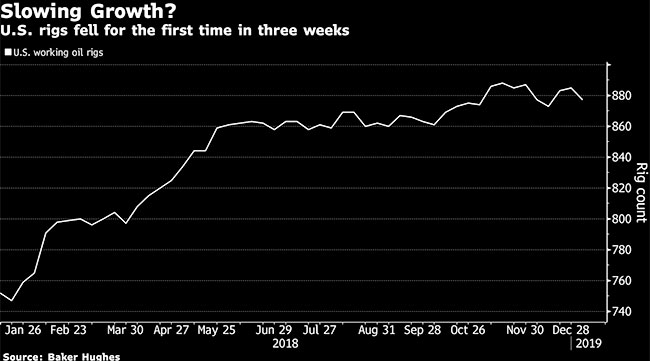Oil Set for Longest Gain in 17 Months on US Economy, OPEC Cuts

Oil headed for its longest stretch of daily gains in more than 17 months as the U.S. Federal Reserve sought to ease investor concerns, China moved to stimulate its economy and OPEC production cutbacks took effect.
Futures in New York climbed as much as 3.2% after a fifth consecutive increase on Jan. 4, when they settled at the highest closing level in two weeks. Crude is rising with other risk assets after Fed Chairman Jerome Powell said the bank could pause interest-rate increases if the U.S. economy weakens. Data last week showed OPEC is following through on pledges to cut output.
Crude has recovered slightly this month after posting its first annual loss since 2015. While Goldman Sachs Group Inc. cut its oil-price forecasts for 2019, citing a re-emerging glut and resilient American shale output, the bank said a 42% drop toward the end of last year was excessive. Volatility persists as the U.S. and China try to negotiate an end to a trade war that risks hurting economic growth and OPEC and its allies pursue supply curbs.
“It could be that prices reached a turning point at the end of last year,” said Giovanni Staunovo, an analyst at UBS Group AG in Zurich. “Now I expect price support as the production cuts agreed by OPEC come into force, as oil demand remains healthy, and as we face a number of supply disruptions in fragile OPEC states.” The market could be tighter in the first quarter than previously expected, he said.

Bloomberg News
The Fed’s Powell said he’s “listening sensitively to the message that markets are sending” about downside risks, invoking events of 2016, when rates were kept unchanged throughout most of the year on concerns of slowing growth in China. The prospect of a hold in U.S. rate hikes weakened the dollar, which is typically positive for commodities such as oil that are denominated in the greenback.
“The statement from the Fed chair was in the direction of what the market bulls have wanted,” said Kim Kwangrae, a commodities analyst at Samsung Futures Inc. in Seoul. “At the same time, there’s increased expectation that OPEC+ will cut its production from this month. The drop in the U.S. rig count is also seen as a bullish factor.”
Working oil rigs in the U.S. fell for the first time in three weeks, by eight to 877, according to data released Jan. 4 by oilfield-services provider Baker Hughes. That’s the biggest decline since the week ended Dec. 7.
In China, a further step by the central bank late Jan. 4 to secure liquidity to the slowing economy also helped assuage some investor concerns. American and Chinese officials will begin negotiations Jan. 7 in the hope of reaching a deal during a 90-day truce in the trade war between the administrations of President Donald Trump and counterpart Xi Jinping.




